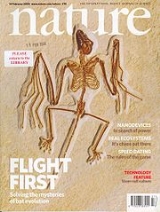
Onychonycteris
Encyclopedia
Onychonycteris is the most primitive of the two oldest known monospecific genera of bat
, having lived in the area that is current day Wyoming
during the Eocene
period, 52.5 million years ago.
in 2003, and placed in a new family when the discovery was published in Nature, in February 2008. Onychonycteris occurs alongside Icaronycteris index
, previously thought to be the most primitive known bat species. Onychonycteris was unique among bats in that it had claws on all five fingers, as opposed to two or three in all other known species, hence Onychonycteris meaning "clawed bat". The specific epithet is a tribute to the fossil prospector and preparator who discovered it, Bonnie Finney.
before or after they evolved the ability to fly. O. finneyi had well-developed wings, and could clearly fly, but lacked the enlarged cochlea
of all extant echolocating bats, closer resembling the old world fruit bats which do not echolocate. This indicates that early bats could fly before they could echolocate.
However, a study in 2010 has also uncovered evidence for other bone structures indicative of laryngeal
echolocation, opposing the conclusions of the previous study by showing that Onychonycteris finneyi did possess the ability to echolocate after all. They did acknowledge that the fossil itself has been flattened by the fossilization process (a 'pancake fossil'), and thus it was difficult to ascertain the exact bone structure and configuration, a fact that still casts a degree of uncertainty on the results of both studies.
It is unknown whether Onychonycteris had the large eyes of most nocturnal animals as specimens with intact eye sockets have yet to be found.
Bat
Bats are mammals of the order Chiroptera "hand" and pteron "wing") whose forelimbs form webbed wings, making them the only mammals naturally capable of true and sustained flight. By contrast, other mammals said to fly, such as flying squirrels, gliding possums, and colugos, glide rather than fly,...
, having lived in the area that is current day Wyoming
Wyoming
Wyoming is a state in the mountain region of the Western United States. The western two thirds of the state is covered mostly with the mountain ranges and rangelands in the foothills of the Eastern Rocky Mountains, while the eastern third of the state is high elevation prairie known as the High...
during the Eocene
Eocene
The Eocene Epoch, lasting from about 56 to 34 million years ago , is a major division of the geologic timescale and the second epoch of the Paleogene Period in the Cenozoic Era. The Eocene spans the time from the end of the Palaeocene Epoch to the beginning of the Oligocene Epoch. The start of the...
period, 52.5 million years ago.
History and description
Two specimens of Onychonycteris were found in the Green River FormationGreen River Formation
The Green River Formation is an Eocene geologic formation that records the sedimentation in a group of intermountain lakes. The sediments are deposited in very fine layers, a dark layer during the growing season and a light-hue inorganic layer in winter. Each pair of layers is called a varve and...
in 2003, and placed in a new family when the discovery was published in Nature, in February 2008. Onychonycteris occurs alongside Icaronycteris index
Icaronycteris
Icaronycteris is an extinct genus of microchiropteran bat that lived in the early Eocene, approximately 52.2 million years ago. Four exceptionally preserved specimens are known from the Green River Formation of North America. There is only one thoroughly described species of bat in the genus, I...
, previously thought to be the most primitive known bat species. Onychonycteris was unique among bats in that it had claws on all five fingers, as opposed to two or three in all other known species, hence Onychonycteris meaning "clawed bat". The specific epithet is a tribute to the fossil prospector and preparator who discovered it, Bonnie Finney.
Flight vs. echolocation
Onychonycteris finneyi was the strongest evidence so far in the debate on whether bats developed echolocationAnimal echolocation
Echolocation, also called biosonar, is the biological sonar used by several kinds of animals.Echolocating animals emit calls out to the environment and listen to the echoes of those calls that return from various objects near them. They use these echoes to locate and identify the objects...
before or after they evolved the ability to fly. O. finneyi had well-developed wings, and could clearly fly, but lacked the enlarged cochlea
Cochlea
The cochlea is the auditory portion of the inner ear. It is a spiral-shaped cavity in the bony labyrinth, making 2.5 turns around its axis, the modiolus....
of all extant echolocating bats, closer resembling the old world fruit bats which do not echolocate. This indicates that early bats could fly before they could echolocate.
However, a study in 2010 has also uncovered evidence for other bone structures indicative of laryngeal
Larynx
The larynx , commonly called the voice box, is an organ in the neck of amphibians, reptiles and mammals involved in breathing, sound production, and protecting the trachea against food aspiration. It manipulates pitch and volume...
echolocation, opposing the conclusions of the previous study by showing that Onychonycteris finneyi did possess the ability to echolocate after all. They did acknowledge that the fossil itself has been flattened by the fossilization process (a 'pancake fossil'), and thus it was difficult to ascertain the exact bone structure and configuration, a fact that still casts a degree of uncertainty on the results of both studies.
It is unknown whether Onychonycteris had the large eyes of most nocturnal animals as specimens with intact eye sockets have yet to be found.

